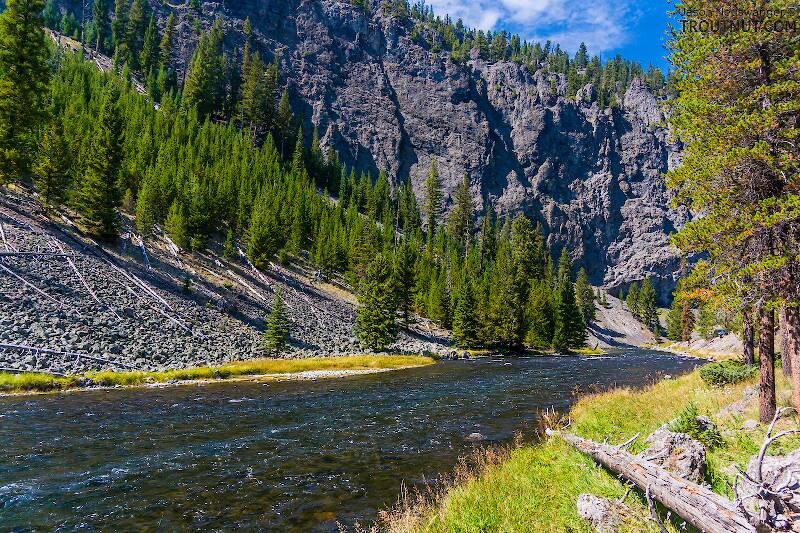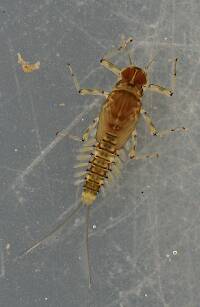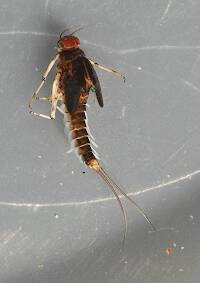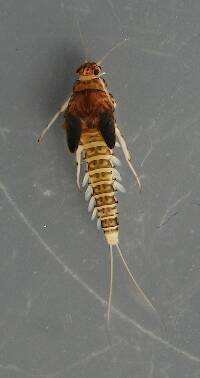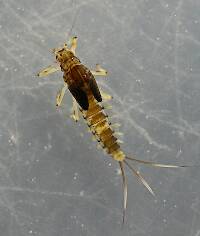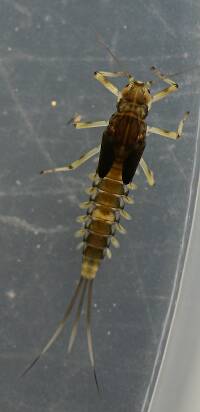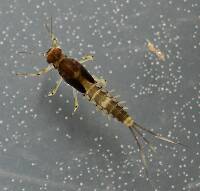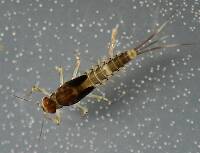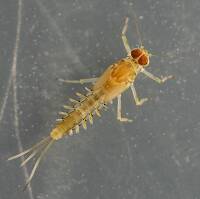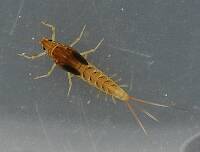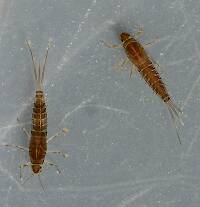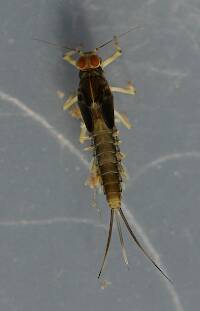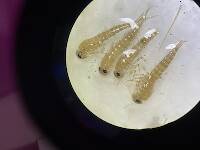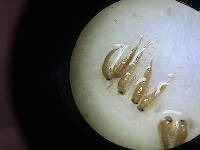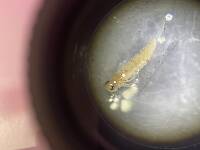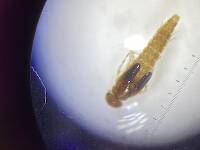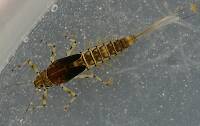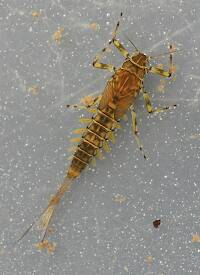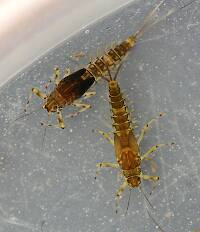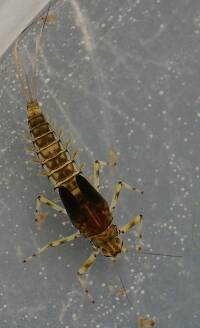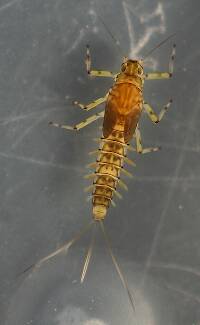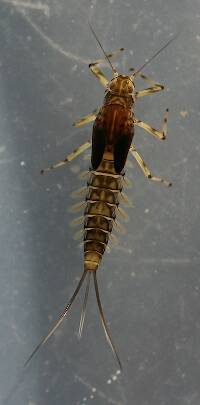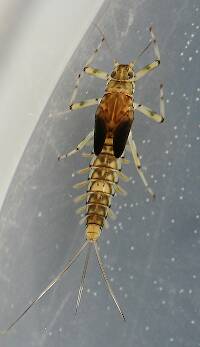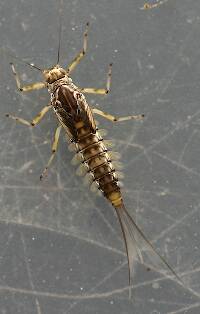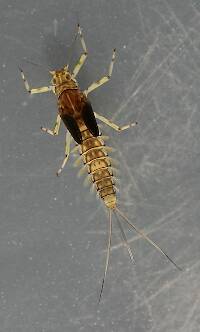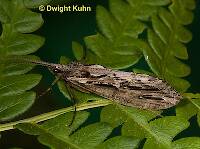
Blue-winged Olives
Baetis
Tiny Baetis mayflies are perhaps the most commonly encountered and imitated by anglers on all American trout streams due to their great abundance, widespread distribution, and trout-friendly emergence habits.
Featured on the forum

This one seems to lead to Couplet 35 of the Key to Genera of Perlodidae Nymphs and the genus Isoperla, but I'm skeptical that's correct based on the general look. I need to get it under the microscope to review several choices in the key, and it'll probably end up a different Perlodidae.

Troutnut is a project started in 2003 by salmonid ecologist Jason "Troutnut" Neuswanger to help anglers and
fly tyers unabashedly embrace the entomological side of the sport. Learn more about Troutnut or
support the project for an enhanced experience here.
Millcreek on Jul 16, 2014July 16th, 2014, 7:50 am EDT
I've been collecting these Baetis nymphs in the Russian River and don't have a clue as to what species they are. Any help would be appreciated.
I've labelled them species #1, #2 and #3. Species #1 and #3 may be the same as I've only collected females for #1 and males for #3. They seem to share some characteristics but I haven't examined the mouthparts yet.
All specimens have been collected from late April to mid July of this year. They seem to prefer relatively calm edges of fast glides. They prefer a clean substrate of small gravel. Measurements are given under each picture.
ADDED NOTE (October 8, 2014)
Spent a few hours over these with the dissecting needles in the last few days and all three appear to be Fallceon species. Diagnostic features for Fallceon nymphs are: no ventral femoral patch of setae, segment 2 of the labial palps poorly developed (minimal 'thumbs' or other projections) and a tuft of setae between the prostheca and molar region on at least the right mandible. References are: Lugo-Ortiz, McCafferty and Waltz "Contribution to the taxonomy of the Panamerican genus Fallceon (Ephemeroptera: Baetidae), (1994). http://www.ephemeroptera-galactica.com/pubs/pub_l/publugoc1994p460.pdf as well as Waltz and McCafferty "Waltz RD; McCafferty WP. 1987. New genera of Baetidae for some Nearctic species previously in Baetis Leach (Ephemeroptera), (1987). http://www.ephemeroptera-galactica.com/pubs/pub_w/pubwaltzr1987p667.pdf
I don't have any idea what species #1 and #3 are. #2 may be Fallceon thermophilos. The ID is tentative and the reasoning behind it is given below towards the bottom of this thread.
PHOTOS REMOVED AND PLACED IN NEW POST 11/11/14 http://www.troutnut.com/topic/8659/Fallceon-spp#42256
I've labelled them species #1, #2 and #3. Species #1 and #3 may be the same as I've only collected females for #1 and males for #3. They seem to share some characteristics but I haven't examined the mouthparts yet.
All specimens have been collected from late April to mid July of this year. They seem to prefer relatively calm edges of fast glides. They prefer a clean substrate of small gravel. Measurements are given under each picture.
ADDED NOTE (October 8, 2014)
Spent a few hours over these with the dissecting needles in the last few days and all three appear to be Fallceon species. Diagnostic features for Fallceon nymphs are: no ventral femoral patch of setae, segment 2 of the labial palps poorly developed (minimal 'thumbs' or other projections) and a tuft of setae between the prostheca and molar region on at least the right mandible. References are: Lugo-Ortiz, McCafferty and Waltz "Contribution to the taxonomy of the Panamerican genus Fallceon (Ephemeroptera: Baetidae), (1994). http://www.ephemeroptera-galactica.com/pubs/pub_l/publugoc1994p460.pdf as well as Waltz and McCafferty "Waltz RD; McCafferty WP. 1987. New genera of Baetidae for some Nearctic species previously in Baetis Leach (Ephemeroptera), (1987). http://www.ephemeroptera-galactica.com/pubs/pub_w/pubwaltzr1987p667.pdf
I don't have any idea what species #1 and #3 are. #2 may be Fallceon thermophilos. The ID is tentative and the reasoning behind it is given below towards the bottom of this thread.
PHOTOS REMOVED AND PLACED IN NEW POST 11/11/14 http://www.troutnut.com/topic/8659/Fallceon-spp#42256
"If we knew what it was we were doing, it would not be called research, would it?"
-Albert Einstein
-Albert Einstein
Entoman on Jul 16, 2014July 16th, 2014, 10:49 am EDT
Well, the common species Diphetor hageni can be eliminated over the presence of seven gills. It's a dollar against a doughnut that B. tricaudatus is probably represented by at least one of the two (three) critter types you have here. As you suspect, the outlying female could be a different species or simply representing an example of dimorphism.
This family now has a lot of closely related genera whose differences often can't be determined from habitus photos alone, no matter how high the quality (yours are excellent, BTW). The easiest thing to look for next is the presence of hind wing pads (they are hidden under the forewing pads in the photos). I suspect they are there. Either way, that will eliminate more genera. After that it's studying mouthparts, body and leg setae, claw structure, the presence of villopore, etc. The old standards of body and tail maculation presented in angling texts and older scientific lit that would make photo ID's possible have proved largely unreliable. Body pattern/color, terminal filament length and tail banding are all highly variable.
This family now has a lot of closely related genera whose differences often can't be determined from habitus photos alone, no matter how high the quality (yours are excellent, BTW). The easiest thing to look for next is the presence of hind wing pads (they are hidden under the forewing pads in the photos). I suspect they are there. Either way, that will eliminate more genera. After that it's studying mouthparts, body and leg setae, claw structure, the presence of villopore, etc. The old standards of body and tail maculation presented in angling texts and older scientific lit that would make photo ID's possible have proved largely unreliable. Body pattern/color, terminal filament length and tail banding are all highly variable.
"It's not that I find fishing so important, it's just that I find all other endeavors of Man equally unimportant... And not nearly as much fun!" Robert Traver, Anatomy of a Fisherman
Millcreek on Jul 16, 2014July 16th, 2014, 12:08 pm EDT
I'd figured the lazy man's method (mine, not yours) wasn't going to get me anywhere. Doesn't usually stop me from trying though. Time to get out the dissecting needles and spend a little quality time with the evil little creatures. Will keep you posted on the progress or lack of it. Thanks for taking a look at them.
"If we knew what it was we were doing, it would not be called research, would it?"
-Albert Einstein
-Albert Einstein
Oldredbarn on Jul 16, 2014July 16th, 2014, 3:05 pm EDT
I'd figured the lazy man's method (mine, not yours) wasn't going to get me anywhere. Doesn't usually stop me from trying though. Time to get out the dissecting needles and spend a little quality time with the evil little creatures. Will keep you posted on the progress or lack of it. Thanks for taking a look at them.
Ditto Kurt on the quality of these photos. Very nice. I'd usually say something smart assed and tell you to skip the dissection and tie on something in a size 18 or so, but you have peeked my interest...Get to work, man, and yes, keep us posted!
Russian River's in Kurt's neck of the woods...My wife and I are planning a trip out that way within the next year or so...Do you think she'll let me pack a rod? :)
Spence
"Even when my best efforts fail it's a satisfying challenge, and that, after all, is the essence of fly fishing." -Chauncy Lively
"Envy not the man who lives beside the river, but the man the river flows through." Joseph T Heywood
"Envy not the man who lives beside the river, but the man the river flows through." Joseph T Heywood
Millcreek on Jul 16, 2014July 16th, 2014, 5:03 pm EDT
Spence -
Glad you enjoyed the photos. Dissection is proceeding, albeit slowly.
No way I'm answering your question about packing a rod, bound to offend you or your wife. :)
Mark
Glad you enjoyed the photos. Dissection is proceeding, albeit slowly.
No way I'm answering your question about packing a rod, bound to offend you or your wife. :)
Mark
"If we knew what it was we were doing, it would not be called research, would it?"
-Albert Einstein
-Albert Einstein
Crepuscular on Jul 17, 2014July 17th, 2014, 4:49 am EDT
Very nice photos! I'd like to see the tarsi, claws, gill trachea, and mouth parts before I hazard a guess.
I'm sure it would not be a problem, just keep her full of that fine pinot they make out there.
Eric
Russian River's in Kurt's neck of the woods...My wife and I are planning a trip out that way within the next year or so...Do you think she'll let me pack a rod? :)
I'm sure it would not be a problem, just keep her full of that fine pinot they make out there.
Eric
Oldredbarn on Jul 17, 2014July 17th, 2014, 7:10 am EDT
I'm sure it would not be a problem, just keep her full of that fine pinot they make out there.
Eric
I like the way you think Eric...Been married awhile, have you? :) You sound like a pro!
Spence
"Even when my best efforts fail it's a satisfying challenge, and that, after all, is the essence of fly fishing." -Chauncy Lively
"Envy not the man who lives beside the river, but the man the river flows through." Joseph T Heywood
"Envy not the man who lives beside the river, but the man the river flows through." Joseph T Heywood
Millcreek on Jul 17, 2014July 17th, 2014, 9:39 am EDT
Eric,
Took a look at your website and it appears that you're pretty adept at photography yourself. Really well done.
Mark
Took a look at your website and it appears that you're pretty adept at photography yourself. Really well done.
Mark
"If we knew what it was we were doing, it would not be called research, would it?"
-Albert Einstein
-Albert Einstein
Millcreek on Jul 17, 2014July 17th, 2014, 2:22 pm EDT
I went back to the beginning with these nymphs using Merritt, Cummins and Berg to key them out to family and genus. I haven't gotten to #1 yet but #2 and #3 are in the family Baetidae, genus Baetis. About 95% sure anyway, have to leave that 5% for room to weasel out if I'm wrong. Not holding out much hope to get them to species level but hopefully will find out eventually what group or complex they're in.
Mark
Mark
"If we knew what it was we were doing, it would not be called research, would it?"
-Albert Einstein
-Albert Einstein
Entoman on Jul 17, 2014July 17th, 2014, 5:40 pm EDT
Yeah, Eric. I'd also like a look under the forewing pads and for the presence/absence of villopore on the forefemora.
"It's not that I find fishing so important, it's just that I find all other endeavors of Man equally unimportant... And not nearly as much fun!" Robert Traver, Anatomy of a Fisherman
Millcreek on Jul 17, 2014July 17th, 2014, 7:43 pm EDT
Kurt - Did look under the forewing pads and there are small rear wingpads and a villopore as well.
"If we knew what it was we were doing, it would not be called research, would it?"
-Albert Einstein
-Albert Einstein
Crepuscular on Jul 18, 2014July 18th, 2014, 2:34 pm EDT
Eric,
Took a look at your website and it appears that you're pretty adept at photography yourself. Really well done.
Mark
Thanks Mark. I'm lucky enough to have some
decent optics. And lots of luck!
Entoman on Jul 18, 2014July 18th, 2014, 5:03 pm EDT
Excellent, Mark. That eliminates a lot of possibilities. Looks like they're all Baetis.
"It's not that I find fishing so important, it's just that I find all other endeavors of Man equally unimportant... And not nearly as much fun!" Robert Traver, Anatomy of a Fisherman
Millcreek on Oct 7, 2014October 7th, 2014, 8:03 am EDT
Apparently I screwed up on one of the IDs here. Got an email from Jeff Webb and he thought Baetis sp.#2 might be a Fallceon species because he noticed a keel between the antennae. He thought it could be Fallceon thermophilos based on some photos taken by Pat Randolph of larvae Randolph had reared.
I went back and reexamined some of the larvae I'd collected and they did have a keel between the antennae and the mouthparts (labium and mandibles) are consistent with Fallceon. I also found a description of the larvae in an article by McCafferty, Meyer, Randolph and Webb "Evaluation of mayfly species originally described as Baetis Leach (Ephemeroptera: Baetidae) from California" (2008). The description of the larvae is on page 587. Link to article is http://www.ephemeroptera-galactica.com/pubs/pub_m/pubmccaffertyw2008p577.pdf.
I went back and reexamined some of the larvae I'd collected and they did have a keel between the antennae and the mouthparts (labium and mandibles) are consistent with Fallceon. I also found a description of the larvae in an article by McCafferty, Meyer, Randolph and Webb "Evaluation of mayfly species originally described as Baetis Leach (Ephemeroptera: Baetidae) from California" (2008). The description of the larvae is on page 587. Link to article is http://www.ephemeroptera-galactica.com/pubs/pub_m/pubmccaffertyw2008p577.pdf.
"If we knew what it was we were doing, it would not be called research, would it?"
-Albert Einstein
-Albert Einstein
Oldredbarn on Oct 7, 2014October 7th, 2014, 8:39 am EDT
I'd also like a look under the forewing pads and for the presence/absence of villopore on the forefemora.
That's what he said! ;) Sorry...Couldn't resist.
Spence
"Even when my best efforts fail it's a satisfying challenge, and that, after all, is the essence of fly fishing." -Chauncy Lively
"Envy not the man who lives beside the river, but the man the river flows through." Joseph T Heywood
"Envy not the man who lives beside the river, but the man the river flows through." Joseph T Heywood
Millcreek on Oct 7, 2014October 7th, 2014, 9:51 am EDT
Spence -
Just remember this phrase from Walt Whitman: Resist much, obey little...:)
Sorry...Couldn't resist.
Just remember this phrase from Walt Whitman: Resist much, obey little...:)
"If we knew what it was we were doing, it would not be called research, would it?"
-Albert Einstein
-Albert Einstein
Millcreek on Oct 8, 2014October 8th, 2014, 5:46 pm EDT
Spence-
This should give you a chance to practice your resistance. Looks like all three of these may be Fallceon species. Added some notes in the original post.
Mark
This should give you a chance to practice your resistance. Looks like all three of these may be Fallceon species. Added some notes in the original post.
Mark
"If we knew what it was we were doing, it would not be called research, would it?"
-Albert Einstein
-Albert Einstein
Quick Reply
Related Discussions
Topic
Replies
Last Reply

